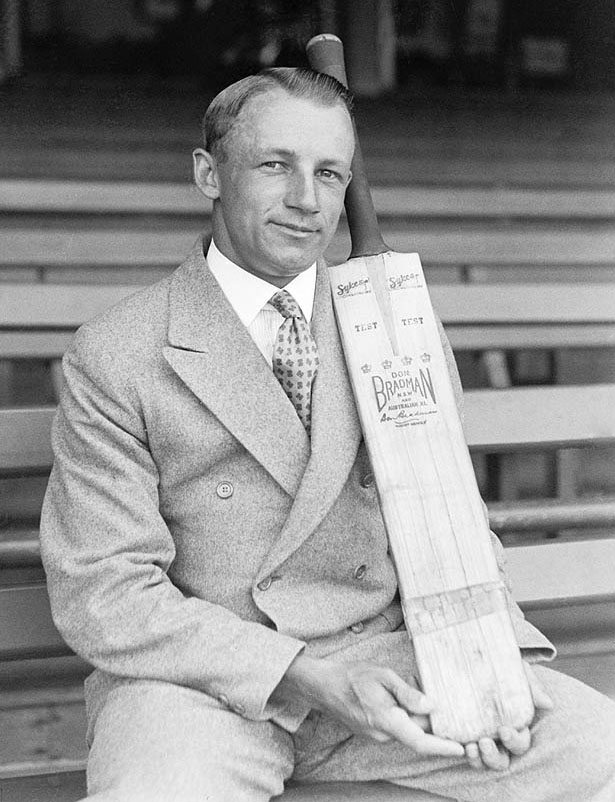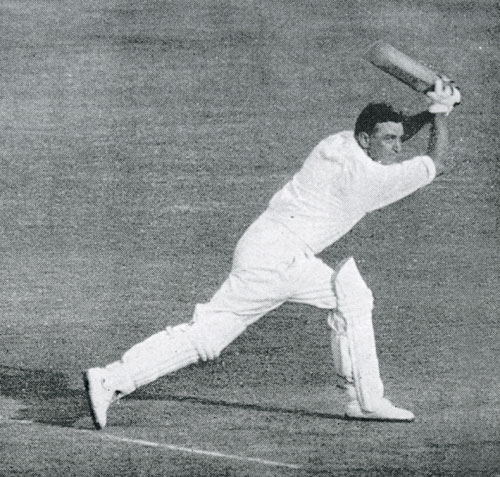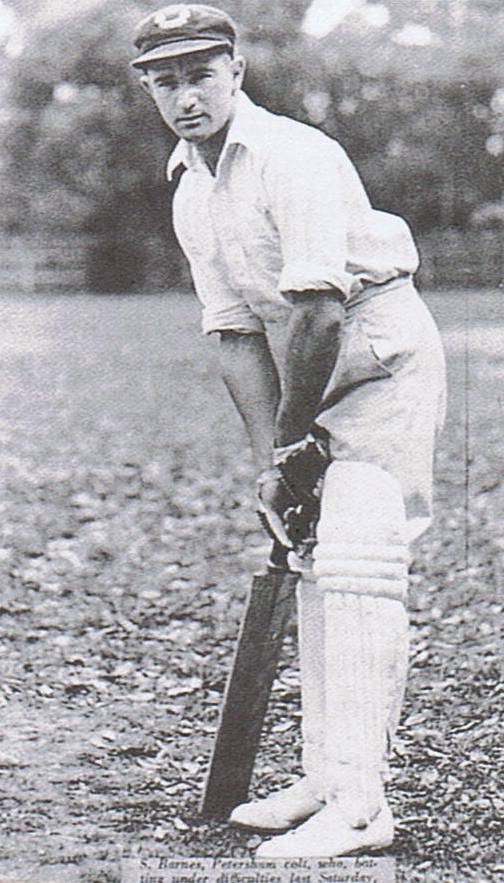|
List Of Australia Test Cricket Records
Test cricket is the oldest form of cricket played at international level. A Test match is scheduled to take place over a period of five days, and is played by teams representing full member nations of the International Cricket Council (ICC). Australia was a founding member of the ICC having played the first Test match against England in March 1877 at the Melbourne Cricket Ground. They have played a total of 849 matches, second only to England who have played just over 1,000. , Australia is the most successful team in Test cricket with an overall winning percentage of 47.58, ahead of their nearest rival South Africa on 38.20. Top order batsman and former captain Don Bradman holds several batting records. Considered to be the greatest batsman of all time, he played 52 Tests between 1928 and 1948. He holds the record for the highest Test average of 99.94, has scored the most Test double centuries with 12, the equal most Test triple centuries with 2 and the most runs scored in ... [...More Info...] [...Related Items...] OR: [Wikipedia] [Google] [Baidu] |
Batting Order (cricket)
In cricket, the batting order is the sequence in which batters play through their team's innings, there always being two batters taking part at any one time. All eleven players in a team are required to bat if the innings is completed (i.e., if the innings does not close early due to a declaration or other factor). The batting order is colloquially subdivided into: * Top order (batters one to three) * Middle order (batters four to eight), which can be further divided into: ** Upper middle order (batters four and five); and ** Lower middle order (batters six to eight) * Tail enders (batters nine to eleven) The order in which the eleven players will bat is usually established before the start of a cricket match, but may be altered during play. The decision is based on factors such as each player's specialities; the position each batter is most comfortable with; each player's skills and attributes as a batter; possible combinations with other batters; and the match situation where ... [...More Info...] [...Related Items...] OR: [Wikipedia] [Google] [Baidu] |
Wicket
In cricket, the term wicket has several meanings: * It is one of the two sets of three stumps and two bails at either end of the pitch. The fielding team's players can hit the wicket with the ball in a number of ways to get a batsman out. ** The wicket is guarded by a batsman who, with his bat (and sometimes with his pads, but see the laws on LBW, leg before wicket), attempts to prevent the ball from hitting the wicket (if it does, he is bowled out) and to score runs where possible. * Through metonymic usage, the dismissal of a batsman is known as the ''taking of a wicket'', * The cricket pitch itself is sometimes referred to as ''the wicket''. History The origin of the word is from wicket gate, a small gate. Originally, cricket wickets had only two stumps and one bail and looked like a gate, much like the wicket used in the North American game of wicket. The third (middle) stump was introduced in 1775, after Lumpy Stevens bowled three successive deliveries to John ... [...More Info...] [...Related Items...] OR: [Wikipedia] [Google] [Baidu] |
Bowling (cricket)
Bowling, in cricket, is the action of propelling the ball toward the wicket defended by a batter. A player skilled at bowling is called a ''bowler''; a bowler who is also a competent batter is known as an all-rounder. Bowling the ball is distinguished from ''throwing'' the ball by a strictly specified biomechanical definition, which restricts the angle of extension of the elbow. A single act of bowling the ball towards the batsman is called a ''ball'' or a '' delivery''. Bowlers bowl deliveries in sets of six, called an ''over''. Once a bowler has bowled an over, a teammate will bowl an over from the other end of the pitch. The Laws of Cricket govern how a ball must be bowled. If a ball is bowled illegally, an umpire will rule it a ''no-ball''. If a ball is bowled too wide of the striker for the batsman to be able to play at it with a proper cricket shot, the bowler's end umpire will rule it a ''wide''. There are different types of bowlers, from fast bowlers, whose primary w ... [...More Info...] [...Related Items...] OR: [Wikipedia] [Google] [Baidu] |
Shane Warne
Shane Keith Warne (13 September 1969 – 4 March 2022) was an Australian international cricketer, whose career ran from 1991 to 2007. Warne played as a right-arm leg spin bowler and a right-handed batsman for Victoria, Hampshire and Australia. He is regarded as one of the greatest bowlers in the history of the sport; he made 145 Test appearances, taking 708 wickets, and set the record for the most wickets taken by any bowler in Test cricket, a record he held until 2007. Warne was a useful lower-order batsman who scored more than 3,000 Test runs, with a highest score of 99. He retired from international cricket at the end of Australia's 2006–07 Ashes series victory over England. In the first four seasons of the Indian Premier League (IPL), Warne was a player-coach for Rajasthan Royals and also captained the team. During his career, Warne was involved in off-field scandals; his censures included a ban from cricket for testing positive for a prohibited substance, and charges ... [...More Info...] [...Related Items...] OR: [Wikipedia] [Google] [Baidu] |
English Cricket Team In Australia In 1946–47
The English cricket team in Australia in 1946–47 was captained by Wally Hammond, with Norman Yardley as his vice-captain and Bill Edrich as the senior professional. It played as England in the 1946–47 Ashes series against the Australians and as the MCC in their other matches on the tour. They were regarded as a sound team which was just as strong as Australia, but due to the Second World War they were an ageing side (only Godfrey Evans was under 28) and their bowling depended heavily on Alec Bedser and Doug Wright, who were overused and exhausted as a result. Australia beat England 3-0 in a five-match series to retain the Ashes; England suffered the worst defeat in a Test series since losing 4–1 to Australia in 1924–25. Since 1881, Tests in Australia were played to finish. That rule was changed for this series, and for the first time in 65 years, a test played in Australia ended in a draw when the third test was drawn. The MCC saw Hammond leading a "Goodwill Tour" of ... [...More Info...] [...Related Items...] OR: [Wikipedia] [Google] [Baidu] |
Sid Barnes
Sidney George Barnes (5 June 1916 – 16 December 1973) was an Australian cricketer and cricket writer, who played 13 Test cricket, Test matches between 1938 and 1948. Able to Batting order (cricket)#Opening batsmen, open the innings or Batting order (cricket)#Top order, bat down the order, Barnes was regarded as one of Australia's finest batsmen in the period immediately following the World War II, Second World War. He helped create an enduring record when scoring 234 in the second Test against England at Sydney in December 1946; exactly the same score as his captain, Donald Bradman, Don Bradman, in the process setting a world-record 405-run wicket#Partnership, fifth wicket partnership (cricket), partnership. Barnes averaged 63.05 over 19 innings in a career that, like those of most of his contemporaries, was interrupted by the Second World War. He made his First-class cricket, first-class debut at the end of the 1936–37 season when selected for New South Wales cric ... [...More Info...] [...Related Items...] OR: [Wikipedia] [Google] [Baidu] |
Partnership (cricket)
In the sport of cricket, two batsmen always bat in partnership, although only one is a striker at any time. The partnership between two batsmen will come to an end when one of them is dismissed or retires, or the innings comes to a close (usually due to victory being achieved, a declaration, a time or over limit being reached, or the match being abandoned in mid-innings for inclement weather or, exceptionally, dangerous may be between more than two batsmen, if one of the original batsmen is retired not out (rather than retired out), since the particular numbered wicket will not have fallen yet. Batting in partnership Batting in partnership is an important skill. When two higher-order batsmen (usually these are the side's best batsmen) are together, they are largely free to play to their own styles (which may be quite different: Marcus Trescothick, an aggressive strokeplayer and Mike Atherton, a defensive stonewaller, enjoyed many successful opening partnerships for Engla ... [...More Info...] [...Related Items...] OR: [Wikipedia] [Google] [Baidu] |
Australian Cricket Team In England In 1930
Australia won the 1930 Ashes series against England, winning two of the matches and losing one, with the other two tests drawn. The Australian tourists were captained by Bill Woodfull, while the home side were led by Percy Chapman, who was dropped in favour of Bob Wyatt in the final Test. Test series summary First Test Second Test Third Test Fourth Test Fifth Test 1930 Australian Team Ashes warm-up Before touring England for the 1930 Ashes Tour, the Australian team led by Bill Woodfull headed to Tasmania to play two first-class matches against Tasmania. The first match was played at the NTCA Ground before the teams moved on to Hobart. Hobart paper ''The Mercury'' said: After leaving Port Melbourne on ship the Nairana, the Australians arrived in Launceston via the Tamar River at 9am on 8 March 1930, as "a big crowd waited to greet the tourists". Later that day, they started their match against a Tasmanian team that included Laurie Nash. The hosts won the toss and ba ... [...More Info...] [...Related Items...] OR: [Wikipedia] [Google] [Baidu] |
Run (cricket)
In cricket, a run is the unit of scoring. The team with the most runs wins in many versions of the game, and always draws at worst (see result), except for some results decided by the DLS method, which is used in rain-shortened limited-overs games when the two teams have had a different number of opportunities to score runs. One run (known as a "single") is scored when the two batters (the striker and the non-striker) start off positioned at opposite ends of the pitch (which has a length of 22 yards) and then they each arrive safely at the other end of the pitch (i.e. they cross each other without being run out). There is no limit on the number of runs that may be scored off of a single delivery, and depending on how long it takes the fielding team to recover the ball, the batters may run more than once. Each completed run, if it occurs after the striker hit the ball with the bat (or a gloved hand holding the bat), increments the scores of both the team and the striker. A b ... [...More Info...] [...Related Items...] OR: [Wikipedia] [Google] [Baidu] |
Century (cricket)
In cricket, a century is a score of 100 or more runs in a single innings by a batsman. The term is also included in "century partnership" which occurs when two batsmen add 100 runs to the team total when they are batting together. A century is regarded as a landmark score for batsmen and a player's number of centuries is generally recorded in their career statistics. Scoring a century is loosely equivalent in merit to a bowler taking a five-wicket haul, and is commonly referred to as a ton or hundred. Scores of more than 200 runs are still statistically counted as a century, although these scores are referred to as double (200–299 runs), triple (300–399 runs), and quadruple centuries (400–499 runs), and so on. Accordingly, reaching 50 runs in an innings is known as a half-century; if the batsman then goes on to score a century, the half-century is succeeded in statistics by the century. Scoring a century at Lord's earns the batsman a place on the Lord's honours boar ... [...More Info...] [...Related Items...] OR: [Wikipedia] [Google] [Baidu] |
Batting Average (cricket)
In cricket, a player's batting average is the total number of runs they have scored divided by the number of times they have been out, usually given to two decimal places. Since the number of runs a player scores and how often they get out are primarily measures of their own playing ability, and largely independent of their teammates, batting average is a good metric for an individual player's skill as a batter (although the practice of drawing comparisons between players on this basis is not without criticism). The number is also simple to interpret intuitively. If all the batter's innings were completed (i.e. they were out every innings), this is the average number of runs they score per innings. If they did not complete all their innings (i.e. some innings they finished not out), this number is an estimate of the unknown average number of runs they score per innings. Each player normally has several batting averages, with a different figure calculated for each type of match ... [...More Info...] [...Related Items...] OR: [Wikipedia] [Google] [Baidu] |







.jpg)

